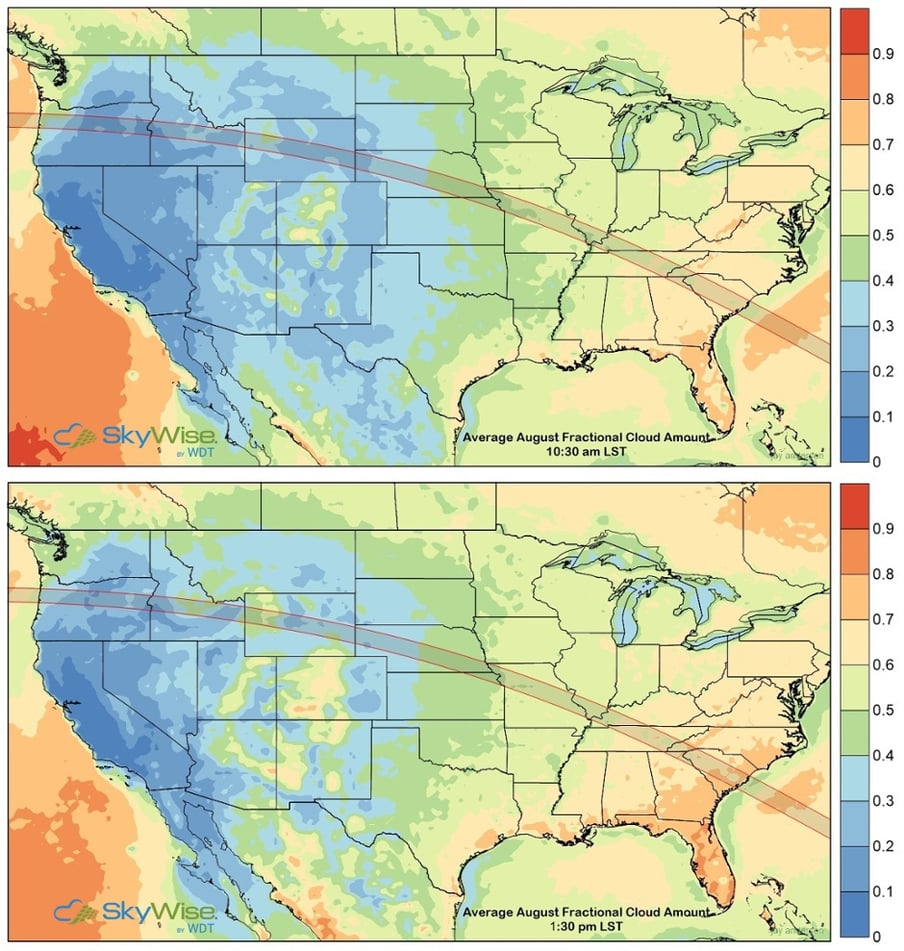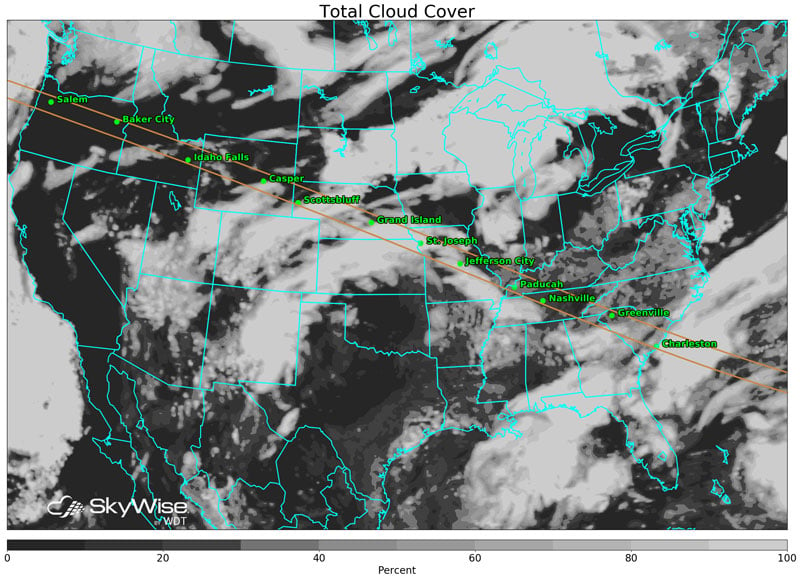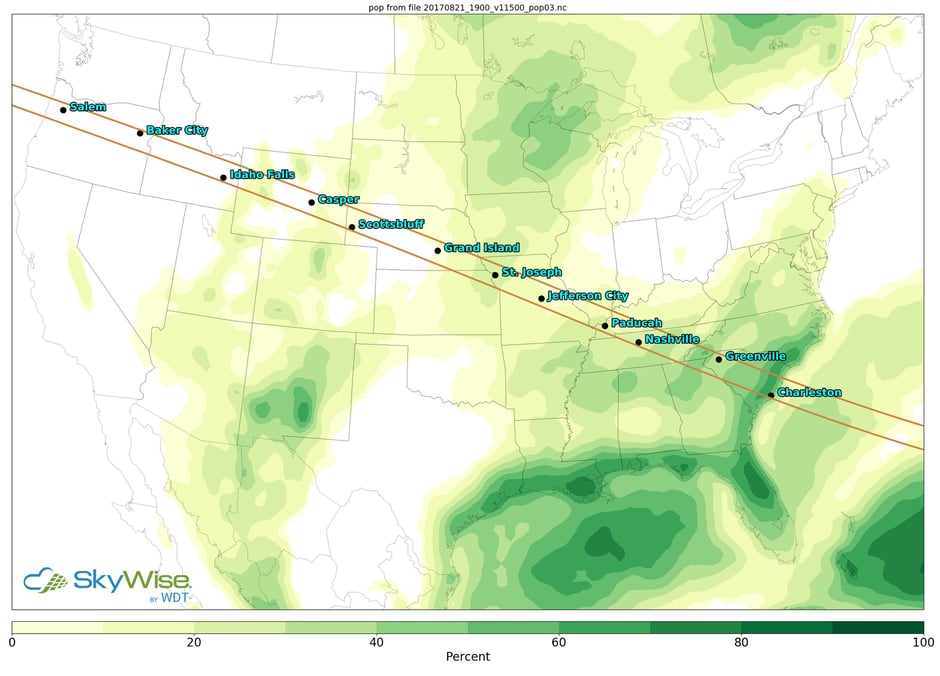Will Your Eclipse be Eclipsed?
by Dr. Chris Porter, on Aug 17, 2017 1:35:30 PM
Just four days remain until the August 21 Great American Solar Eclipse, and anticipation of the celestial event continues to grow. Many made travel plans for the path of totality months in advance. Those willing to travel to locations with the highest likelihood of clear conditions had to rely on climatological forecasts of cloudiness. In an earlier eclipse blog, WDT’s Steve Strum pointed out best conditions climatologically would be expected over the western United States, particularly Oregon, Idaho, and Wyoming based on climatology alone.
The image below is the average fractional cloud amount for August. The darker green shade would mean, on average, 40% of the sky is covered by clouds. If you checked climatology before deciding where to go for the eclipse, Oregon to western Nebraska would have looked like prime locations.

For the first half of August, the general cloud cover pattern across the United States has been similar to climatology, as shown in the figure below. This composite image represents total cloud cover across the United States for August 1 through the 15 using gridded datasets within WDT’s SkyWise Platform. At each grid point within the CONUS SkyWise domain, the maximum percent total cloud coverage within a four-hour time window from 1600 to 2000 UTC (9 am PDT to 4 pm EDT) was calculated for each day. This four-hour period encompasses all phases of the eclipse as it progresses from Oregon through South Carolina. The gridded daily maximums were then averaged over the 15-day period to create the composite image.

An upper-level ridge existed over the western United States for much of the first half of August keeping Oregon and Idaho cloud free for many days. Repeated waves of convection brought cloudy skies and rain to the plains and points southeastward, especially along the Gulf Coast into northern Florida. Thus, in general, using a climatological forecast of cloud cover would have provided valuable information on where to travel to best see the eclipse. But of course, it only takes one relatively small, ill-timed cloud to obscure one’s view of the awe-inspiring corona of the sun during totality.
Now that less than a week remains until the eclipse, attention turns to high-resolution forecast models that can provide point specific cloud condition forecasts at the time of totality on August 21. WDT’s SkyWise platform provides future forecasts of total cloud cover as shown below.

This image represents one deterministic model solution for cloud cover at 1800 UTC (1 pm CDT) on August 21. Again, Oregon and Idaho remain cloud-free. But outside of those two states, clouds are possible over the remaining portions of the totality path. In fact, if this particular model solution were to come true, many people’s view will be spoiled with only portions of western Wyoming and eastern Tennessee being clear enough to see the sun and moon.
Another way to address the possibility of adverse weather conditions is to examine the probability of precipitation over a wide range of model forecast solutions. For example, the image below shows the probability of precipitation over a three-hour period during which the total eclipse will occur from an ensemble of 51 different model forecasts.
 Probability is high for precipitation along the Gulf Coast as well as Atlantic Coast from Florida up through North Carolina. Oregon and Idaho appear to be in the clear with very little chances of rain. Wyoming, eastern Nebraska, and Missouri have low chances of precipitation, but probabilities increase the closer you get to the Atlantic Coast. One caveat to this type of forecast is clouds can still exist with little to no precipitation reaching the ground. But this type of examination provides a look at a spread of possible weather model forecasts, not just one. In the end, wherever your chase of the total eclipse may take you, may the odds be ever in your favor.
Probability is high for precipitation along the Gulf Coast as well as Atlantic Coast from Florida up through North Carolina. Oregon and Idaho appear to be in the clear with very little chances of rain. Wyoming, eastern Nebraska, and Missouri have low chances of precipitation, but probabilities increase the closer you get to the Atlantic Coast. One caveat to this type of forecast is clouds can still exist with little to no precipitation reaching the ground. But this type of examination provides a look at a spread of possible weather model forecasts, not just one. In the end, wherever your chase of the total eclipse may take you, may the odds be ever in your favor.
More information about SkyWise by WDT GIS data can be found here. WDT is a proud ESRI Silver Partner.









